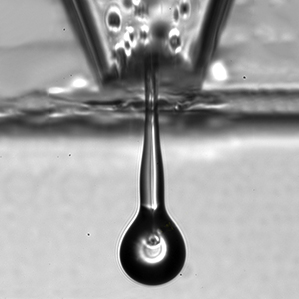Printed Eye Cells Could Help Treat Blindness
Ink-jet printing technology could be a way to build new tissue meant to restore vision to people suffering from common forms of blindness due to retinal degeneration.

Researchers at the University of Cambridge used a standard ink-jet printer to form layers of two types of cells taken from the retinas of rats, and showed that the process did not compromise the cells’ health or ability to survive and grow in culture. Ink-jet printing has been used to deposit cells before, but this is the first time cells from an adult animal’s central nervous system have been printed.
The group hopes to develop the technology into a tool for generating new tissues that can be grown outside the eye and implanted in patients with retinal damage. Alternatively, the technique could potentially be used to insert cells directly into damaged retinas during ocular surgery, says Keith Martin, a professor of ophthalmology at the University of Cambridge, who led the research.
Scientists can grow single layers of cells in cultures, but printing may be a more effective way to engineer new tissues and organs, which are made of multiple different cell types positioned in intricate three-dimensional orientations. The retina, for example, is a highly organized, multilayered structure composed of various types of neurons and non-neuronal cells. The new ink-jet technique makes it possible to place retinal cells in “very precise and special arrangements,” says Martin.
Martin and his colleagues made printable suspensions, each containing one of two cell types isolated from adult rat retinas: neurons called retinal ganglion cells and non-neuronal cells called glia, which provide vital support for neurons. Certain other types of embryonic neuronal cells have been successfully deposited with ink-jet printing before, but these are the first printed mature neurons. Before the study, some researchers doubted whether such cells could withstand the stresses of ink-jet printing. Compared with embryonic cells, “adult neuronal cells are really quite fragile,” says Martin. “We were actually quite surprised at how well these adult neuronal cells survived the printing process.”
Martin says the group must now perform further tests to make sure that the cells are behaving the way they should. After that, the researchers plan to try printing additional layers and cell types, including light-sensitive neurons called photoreceptors and another type of non-neuronal cell called retinal pigment epithelial cells. Both are essential to normal retinal function.
Rebuilding the retina is an extremely difficult challenge, because “you have to reconstruct what is basically a small computer” whose function arises from a very complicated architecture in which multiple cell layers are connected in a number of different ways, says Joel Schuman, chairman of the department of ophthalmology at the University of Pittsburgh. If this architecture could be re-created using a printer, “you would be so many steps ahead of trying to grow the layers individually and then put them together,” he says.
Whether such printed structures will actually work in the eye, though, remains an unanswered question, cautions Schuman. Not only must they survive, but they must integrate with the rest of the retina and ultimately connect to the brain via the optic nerve.
Keep Reading
Most Popular
Large language models can do jaw-dropping things. But nobody knows exactly why.
And that's a problem. Figuring it out is one of the biggest scientific puzzles of our time and a crucial step towards controlling more powerful future models.
The problem with plug-in hybrids? Their drivers.
Plug-in hybrids are often sold as a transition to EVs, but new data from Europe shows we’re still underestimating the emissions they produce.
Google DeepMind’s new generative model makes Super Mario–like games from scratch
Genie learns how to control games by watching hours and hours of video. It could help train next-gen robots too.
How scientists traced a mysterious covid case back to six toilets
When wastewater surveillance turns into a hunt for a single infected individual, the ethics get tricky.
Stay connected
Get the latest updates from
MIT Technology Review
Discover special offers, top stories, upcoming events, and more.